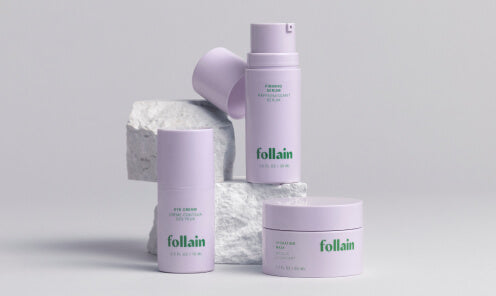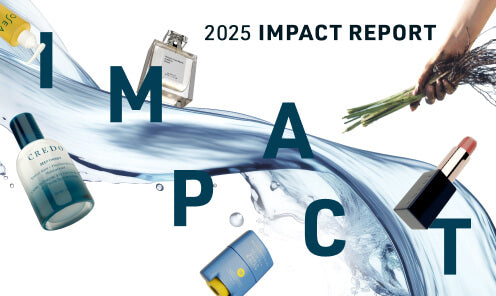By Mia Davis, Credo's Director of Environmental and Social Responsibility
Seems everywhere we look, there is buzz about a new skin care ingredient. Is it clean? Is it not? (And how do I even pronounce it?)
Consider Credo your bible, your glossary and your cheat sheet. Please see The Dirty List™ for all of the ingredients, which due to safety and/or environmental concerns, we ask our brand partners to avoid using.
In addition, here are other ingredients you may be wondering about (for example, carmine and phenoxyethanol). We explain what it is, why it is used, and where credo lands on allowing it, including specific guidelines for compliance.
Beeswax (and other Bee Products)
Credo allows Beeswax, Honey, Pollen and Propolis (all from bees) which are safe, effective ingredients. We ask our brand partners to obtain assurance from their ingredient suppliers that the bees are treated humanely. Bee populations are in big trouble, and that doesn’t bode well for plants, agriculture, or humans. So, we encourage brands to do the following to help increase the chances for bee health and to reduce our industry’s negative impact:
• Avoid using Royal Jelly
• Seek honey, wax and any other bee product from beekeepers that care about the humane treatment of bees
• Avoid using/purchasing neonicotinoids (in your garden, home and as a business)
Carmine
This red pigment (also known as Cochineal, Cochineal Extract, Crimson Lake, or Carmine Lake, Natural Red 4 C.I. 75470) is allowed but must be clearly indicated on ingredient labels. It comes from scale insects, such as the cochineal scale, and is often found in color cosmetics. Learn more about Carmine here.
Chemical combinations
Some ingredients pose little-to-no hazard on their own, but may create a new concern when combined. While chemical reactions are hard to assess for their potential impact (and even more difficult for Credo to monitor), we ask our brand partners to use caution and think about consumer health and the environment down the line.
• Avoid combination of potassium sorbate + ascorbic acid + ferric salts There is limited evidence showing that these three ingredients in combination can mutate cell DNA. So, when possible, we ask that brands avoid the combination.
• Sodium benzoate + ascorbic acid These ingredients together can form benzene, a carcinogen. The ratio of sodium benzoate to ascorbic acid, pH levels and the addition of other acids or bases will all impact the formation of benzene. In most cosmetics using the combination of sodium benzoate and Vitamin C, high concentrations of Vitamin C neutralize the benzene formation. The pH in cosmetic products are usually in the range (pH of 3 to 7) where benzene will not form. (And at pH 7 and higher, no benzene is formed.) So, although it is unlikely to be an issue, we ask that brands please work with their chemists to avoid potential benzene creation.
Colorants
There are natural, naturally-derived and synthetic colorants. We allow all of them in color cosmetics (makeup)--products that are meant to impart color. We do not carry colored/dyed skin or body care. Natural and naturally-derived colorants are from plants, minerals, or insects (carmine). Mineral colors are often viewed as healthier or more sustainable than synthetic colors, which are derived from petroleum. This isn’t necessarily the case. Mined minerals can be contaminated with heavy metals (like lead, a known neurotoxin). Some minerals may be mined in unsustainable ways that harm the ecosystem and/or exploit people (including child labor, a problem in India’s mica mines). Some natural pigments can fade faster and disperse more quickly than their synthetic counterparts (though formulating with natural pigments has come a long way). That said- petroleum is not a sustainable feedstock either.
Credo carries gorgeously clean brands that choose their ingredients that support their goals—some are super-dedicated to natural and will only use mineral-based colorants. Others brands make a conscious choice to use synthetic colorants, which are likely used at lower percentages than their mineral counterparts. We ask that brands work with their suppliers to control for heavy metal contamination and seek materials from suppliers that guarantee they do not use child labor. Whatever you choose, we support you and want to keep color cosmetics fun.
Fragrance
“Fragrance” is a combination of materials added to a cosmetic to produce a scent or to mask an odor. Fragrance is used in skin care, body care and the fragrance category at large from parfum/perfume, cologne, body spray, etc. Credo prefers natural fragrances over synthetic fragrances, but we do allow synthetic fragrances (but no phthalates, nitromusks or polycyclic musks, as explained in our Credo Clean Standard). We require that every single product has categorized fragrances (e.g. natural, synthetic), and we push brands to fully disclose all fragrance ingredients so that consumers can make more informed choices.
“Glycols”
Polyethylene Glycol, or PEG, is an Ethoxylated ingredient and is on The Dirty List™. Credo allows other “glycols” e.g. Pentylene Glycol. These are synthetic chemicals used to attract moisture to the skin, and help keep products stable. These ingredients do not appear to pose a safety risk for most people.
Heavy Metals
Lead, Nickel, Cadmium, and other heavy metals are common at trace levels in both natural mineral pigments and synthetic colorants. While these very low levels (in the low parts per million range) pose little risk to human health, many heavy metals build up in our bodies over time, and cosmetics are not our only source of exposure. For that reason, Credo takes this contamination very seriously. We believe that heavy metals should be at the lowest possible levels, so we ask that our brand partners not only meet the minimums established by FDA for cosmetics, but that they go further. For example, we ask that they work with ingredient suppliers and ask for consistent batch testing on colorants (as opposed to testing a colorant once and assume that the results are consistent from batch to batch).
Japanese Honeysuckle
This natural preservative compound looks like a paraben, and in chemistry, structure determines function. So, while we don’t have any data indicating that it is a potential endocrine disruptor (which is the concern with parabens), out of precaution, we encourage brands to avoid it.
Lanolin and Keratin
Lanolin is a safe and effective oil that comes from sheep’s oil glands. Keratin is also derived from sheep’s wool, among other animal sources, though keratin used in cosmetics appears to be from wool. Sheep do not need to be killed or harmed to obtain lanolin or keratin, but sheep farmers often use insecticides on the animals to prevent ticks, lice, etc, and some of those chemicals are known to be toxic. Sheep-raising is a global industry, and at this time there are no established certifications or monitoring organizations that ensure humane treatment. We hope that by encouraging our brand partners to ask their suppliers questions and ideally obtain validation of humane treatment, we can create clear demand for humanely raised and better ingredients.
Nanoparticles
Nanoparticles (which range in size from 1 to 100 um, or nanometers) are extremely small particles which have been synthetically engineered to be very tiny, or which are micronized versions of larger, naturally occurring particles. The smaller particle size changes the function of the ingredient, which is why they are useful. However, the smaller size might impact health or the environment as well. A number of beauty companies sell products advertised as containing “non-nano” titanium dioxide and zinc oxide, used in sunscreens and in color cosmetics. These claims are often misleading. According to EWG, “while particle sizes vary among manufacturers, nearly all would be considered nanomaterials under a broad definition of the term, including the definition proposed in 2011 by the federal Food and Drug Administration.”
Credo asks companies to avoid new molecules which have been developed specifically to have different characteristics, like buckyballs, fullerenes, nanotubes, liposomes, or quantum dots. We also ask that companies avoid any nanoparticles—even minerals like zinc and titanium dioxide—in products which may be inhaled (sprays and powders). We will keep our eyes on the literature around the safety and sustainability of nanoparticles and as always, keep our clean beauties in the loop.
Palm Oil and Palm-Derived Ingredients
Palm Oil and ingredients that are derived from palm oil are found in many consumer products. Palm oil is a natural, effective, highly useful and safe ingredient, and a potentially sustainable crop. Currently most palm oil is grown and harvested in an unsustainable and destructive manner, wreaking havoc on the local ecosystem, communities, and the climate. Credo feels that the solution is not to prohibit palm oil, but to create a clear demand for sustainably produced palm oil. We will be working with brands to increase the demand for sustainable palm.
Petroleum-Derived and/or Synthetic Ingredients
Credo encourages brands to use natural or naturally-derived ingredients instead of petroleum-derived ingredients whenever possible, but we do not prohibit all petroleum-derived or synthetic ingredients. Why? Synthetic ingredients can be safe and sustainable, and natural ingredients can be harmful and unsustainable. Clean Beauty isn’t about “synthetic vs natural,” but instead about carefully evaluating ingredient sources for their potential impacts. To that end, we ask our brands to avoid the “dirtiest” of synthetic ingredients (which are on The Dirty List™), and to obtain certificates of analysis, and/or manufacturing/growing practices, to address potential contamination issues.
Despite being a "controversial" ingredient, phenoxyethanol has a similar safety profile as other commonly used preservatives. Preservatives are necessary to kill/prevent the growth of microbes in any product which contains water, so they are not a luxury ingredient but instead a "must have." (Please see our blog on this topic for more info.) The EU Scientific Committee on Consumer Safety published a final opinion on phenoxyethanol in 2016. The take home of the 102 page document: The SCCS considers 2-phenoxyethanol safe for use as a preservative with a maximum concentration of 1.0%, which is the maximum level that cosmetics formulators are using.
Toxicologists using the GreenScreen(TM) for Safer Chemicals, a globally recognized tool that identifies hazardous chemicals and safer alternatives, assigned Phenoxyethanol the Benchmark Score™ of 2 (“Use but Search for Safer Substitutes”). This score (which ranges from 1 to 4) is based on a comprehensive review of the scientific literature, which takes into account hazard information on a variety of endpoints, and even the data gaps on the chemical (meaning that, for example, we do not know its potential to disrupt the hormone system, and we can't assume that no data means it is safe). Here is a link to the GreenScreen assessment on this ingredient.
Several other preservatives used in skin care and beauty also score a Benchmark 2, but they are more likely to irritate the skin and cause sensitization, and they are often more toxic to aquatic life. There are a handful of preservatives systems that appear to be safer/cleaner options than phenoxyethanol, but they don't always work as well for certain products. The overall chemistry of a product; its pH, the packaging, the expected shelf life, whether it is leave on or rinse off – this is all taken into account when choosing preservative systems. So, there isn't really one "silver bullet," and even if there was one perfect preservative, we wouldn't want every single product to use it as microbes could become resistant and people may become desensitized.
SO- we clearly need more clean options here. Credo is urging the chemical suppliers to innovate! Check out this fantastic report by Environmental Defense Fund for more information on this issue.
Quaternary Ammonium Compounds
These are a class of chemicals that are commonly used in consumer products. They show up most often as antimicrobial “active ingredients” in disinfectant cleaners, but are also widely used in the beauty industry, usually as conditioning and antistatic agents in hair care products. “Quats” as they’re known, usually have “…onium chloride” in their names, e.g. Benzalkonium Chloride. We are prohibiting quats as preservatives but allowing them as needed for anti-static/smoothing agents.
There are 724 quats listed in the Personal Care Products Council ingredients database. Some of these are rarely if ever actually used. Commonly used quats in hair care include Guar Hydroxypropyltrimonium Chloride and Hydroxypropyltrimonium Honey. There is a large body of science indicating that quats used as antimicrobials have been linked to bacterial resistance and to skin and organ irritation, among other emerging concerns. And they’re likely not even necessary--there is no proof that these chemicals protect against germs any better than regular soap and warm water hand washing.
Credo agrees with public and environmental health organizations calling for restrictions on quats in cleaning products, and we do not allow them for use as preservatives--there are far better options available. But we have not outright banned them in products because some, like Guar Hydroxypropyltrimonium Chloride, for example, are seemingly low-hazard (with limited data) but very functional as skin conditioning or anti-static ingredients. While companies have been trying to work around these ingredients (by adding more natural emollient ingredients, for example), consumers have been clear about their preference for the performance attributes that these ingredients bring to the product.
Retinyl Palmitate
As a retinoid, this ingredient may increase sun sensitivity when applied to skin and worn in direct sunlight. However, Retinyl Palmitate is likely of little concern in night creams.
Silicones (Linear)
Linear silicones, like Dimethicone and others, can improve skin texture, fill in wrinkles, and help condition the hair. It’s unlikely that these large, stable molecules are a health concern for cosmetics users, but there are a few things you may want to know so that you can make an informed decision:
• Silicones do not biodegrade well (or at all); they have a negative impact on the environment.
• Depending on the size of the ingredient and your skin’s sensitivity, silicones may clog pores. So those with acne-prone skin may want to avoid products that list silicones as an ingredient.
Talc
Talc is used in a range of consumer products, including color cosmetics and body (talcum) powders. There are two potential concerns regarding talc: 1) the risk of asbestos contamination and 2) the risk of small particles getting into the body through inhalation or perineal (genital) use of talc-based body powder. Credo does not carry talcum powder, and we ask companies using talc in cosmetics to obtain documentation that the talc they are purchasing has been tested for asbestos, and none was found, even at trace levels.
Phew…yes, that’s a lot of information. Think of this as your go-to blog about the good, the bad, the ugly and the Credo Clean. The more you know, the clearer and better the clean beauty path is to navigate. We did the research…so you can clean up good knowing it truly is “all good.”

Mia is the Director of Environmental and Social Responsibility at Credo. Her career began in the environmental health movement. In 2007, she co-led the Campaign for Safe Cosmetics. Davis was Head of Environment, Health and Safety at Beautycounter for 5 years, and she's now helping Credo brands and customers define and lead the "clean beauty" sector.










